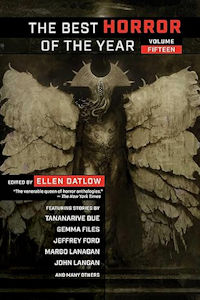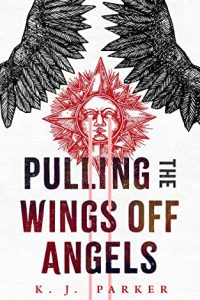Paul Di Filippo Reviews The Best Horror of the Year: Volume 15 edited by Ellen Datlow
 The Best Horror of the Year: Volume Fifteen, edited by Ellen Datlow (Night Shade 978-1949102727, trade paperback, 432pp, $19.99) January 2024
The Best Horror of the Year: Volume Fifteen, edited by Ellen Datlow (Night Shade 978-1949102727, trade paperback, 432pp, $19.99) January 2024
“Curation” is an overworked word these days, when, on the internet, everything from a collection of Pez dispensers to an Instagram stream of dinner photos is deemed to be “curated.” And yet there’s really no better term to be applied to an assemblage of art put together by someone with wisdom, experience, vision, and excellent taste. Such a description easily fits editor Ellen Datlow, who has been commissioning, collecting, collating, and arranging stories for over four decades. The current installment of her Best Horror series is number fifteen, but that only reflects the reboot that happened in 2009. The original series—with various co-editors—kicked off in 1988—35 years and counting!
The volume under inspection here today seems to me—a relative dilettante in the horror genre—to incorporate a myriad of styles, themes, and approaches which, taken together, must necessarily constitute an illuminating wide-angle portrait of the field as it stands today.
Moving beyond Datlow’s useful, nearly-60-page summary of activity and trends for the year past, we come to “Solivagant”, by Angela Slatter. Our narrator, Kitty, is saddled with an evil and malicious companion—almost an incubus—who leaves a trail of death and destruction behind, keeping the pair always on the run. But finally Kitty forces a showdown and parting of the ways, with no small measure of danger. The baseline normality of Kitty and her elderly neighbor Magda heightens the uncanniness.
Jeffrey Ford has probably never written an unsatisfying story, and “Gate 9” is no exception. When a father and daughter are maliciously parted in an airport, the dad begins an implacable Dischian descent into chaos and surrealism.
“Flaming Teeth” is Garry Kilworth’s bravura excursion into the genre of “undiscovered country,” a mode which modern geographic progress would seem to have rendered obsolete. But Kilworth’s depiction of his stumblebum cast and of the strange island—”shrouded in mist for eons or… slipped through a portal from a parallel world”—where his fiery-mouthed monster lives is forceful and believable.
Steve Toase brings us “On the Hills, the Knitters”, where that most domestic and reassuring of crafts, involving harmless needles and yarns, takes on a menacing vibe and presence worthy of an outing by Lucius Shepard.
“New Fox Smell” by Livia Llewellyn finds an adolescent named Laura heading for a stay with a country friend of dubious character, but malign forces ensure instead that she crosses a dimensional barrier to the cruel Fox Island.
“The Harvester of Ladslove”, given us by Steve Duffy, is our first piece with a vivid historical venue—World War I, in this case. A shattered soldier, Captain Rawnsley, reluctantly tells a story of Machenesque battlefield supernaturalism—until past horrors intrude on the present-day country house. Duffy limns that era’s ambiance with deft details and tone.
Tananarive Due takes us to an unsettling “Incident at Bear Creek Lodge”. An atmosphere akin to Sunset Boulevard prdeominates, as our young male protagonist Johnny—a fetching mix of courage and bewilderment—is consigned to the care of his delusional grandmother, a faded star with merciless ways.
Grandmother suddenly glared at me like I was everything that had let her down in life, her eyes so angry that my skin prickled. Then her face softened to a mask: not a smile, but less severe. The transformation was so fast and convincing that I had to remind myself that Grandmother had been a famous actress, after all. Her eyes were as flat as the settled snow.
A killer rodeo bull and a beautiful woman lie at the heart of “The Myth of Pasiphaë” by Andy Davidson. The voice of the narrator— “’A bull is a lonely creature,’” I said. ‘They are captives of their own genes.’”—along with the unique setting guarantee a captivating tale.
“The Loneliness of the Long-Distant Reporter” by Daniela Tomova, discloses our plucky journalist heroine in Norway, covering a unique sporting event, involving the undead.
Each box is well lit and large enough for a human body. Each box does, in fact, contain a body.
The revenants.
Each stands alone—a grim, life-sized action figure—under a dour fluorescent fixture mounted on the inside of the box. The lighting isn’t helping. It only deepens the shadows falling in angles that should be impossible on a human face, so the first thing you see are the eyes—pale, opaque, and unblinking. Stone.
One of my two favorite tales is Alison Littlewood’s “In the Wabe”. The famed statue of Alice in NYC’s Central Park proves to be a portal to a place where chronological years ebb and flow like advancing and receding tides. A mother loses her daughter to the nexus, then sacrifices everything for her return. I was put in mind of Gilliam’s The Fisher King.
A single page of deftly poetic flash fiction constitutes Jordan Shiveley’s “New Meat(TM)”.
David Surface’s “Eyes Like Small Black Stones” charts the intersection of a mentally disturbed boy named Jack with his newly reached ancestral home of Castle Hill, where Jack’s grandfather rules with an iron hand. Echoes of Shirley Jackson preside.
Talented veteran Gemma Files delivers “Bb Minor, or The Suicide Choir: An Oral History”, whose transcript format gracefully allows for a suspenseful unfolding of cultish evil. “When we opened the door at last, pried it open, there was this…you know that kind of noise when you open a can of coffee? Vacuum sealed? It was like that. And then this rush of cold coming out, intense, like the dead of winter.”
The creepy “Samuel King, renowned puppeteer” manifests in a quiet nursing home and brings Bradbury-like unease and disorder. Thus goes “Lifelike” by Gary McMahon.
Psychic crime scene investigator Alistair comes upon gory abominations at London’s zoo (“The Zoo” by Gemma Amor) and learns of a most unlikely perp—who nonetheless threatens further destruction unless stopped.
In “Dinner Plans With Baba Yaga”, Stephanie M. Wytovich gives us an incantatory poem of great power: “There’s a routine to this, a ritual, the way/the kettle is forever on, screaming like a dying/red fox. I drink a broth made from feathers stewed/with baby teeth and sage….”
Running an Airbnb is an innocuous pastime, right? Not so in “The Collection” by Charlie Hughes. Layla and Geoff learn that their first guests include a young man named Joshua Sheldon, whose manner—and alien familiar creature—are most unsettling.
The second of my choicest entries is “Tell-Tale Tit” by the irreplaceable Margo Lanagan. I can’t really spoil it for you with details, except to say that its grand guignol novum combines the best of Kafka and Margaret Atwood in a bold and caustic parable of societal prohibitions and punishments.
“The Last Box”, by Luigi Musolino, features a type of circus performer for whom I hold a particular affection, having used such a one in my novel Spondulix. Generally known as “enterologists,” these contortionists squeeze themselves into incredibly small spaces. In Musolino’s tale, those spaces extend to emotional domains as well, and our bereaved son must watch as his father misuses his skills to dire ends.
Jacob Steven Mohr, in his “1855”, steps forward with this volume’s second historically sited story. Luca Palermo is an institutionalized orphan whose strange rituals of self-consolation open up entrances into our reality for a spirit known as the “mamma nascosta.” Refreshingly, there are no villains here, just fallible humans trying to do their best against the inexplicable.
We conclude suitably with an offering from the esteemed and well-known John Langan, titled “Enough For Hunger and Enough For Hate”. In an icy wasteland, our formidable heroine Michelle Word, in order to avenge her brother, must confront her monstrous nemesis, Walter Ivorsson. The eloquent long dialogue between them, seemingly low on immediate action, instead provides grim suspense and terror. The shattering catharsis is well sustained.
Looking back at the wide variety of voices, venues, fantastical riffs, and angles of literary attack curated here, one marvels not only at the healthy heterogeneity of the horror field, but at Datlow’s ability to select and shuffle it all together into an appropriately abbreviated yet complex and rich tapestry.
 While you are here, please take a moment to support Locus with a one-time or recurring donation. We rely on reader donations to keep the magazine and site going, and would like to keep the site paywall free, but WE NEED YOUR FINANCIAL SUPPORT to continue quality coverage of the science fiction and fantasy field.
While you are here, please take a moment to support Locus with a one-time or recurring donation. We rely on reader donations to keep the magazine and site going, and would like to keep the site paywall free, but WE NEED YOUR FINANCIAL SUPPORT to continue quality coverage of the science fiction and fantasy field.
©Locus Magazine. Copyrighted material may not be republished without permission of LSFF.







